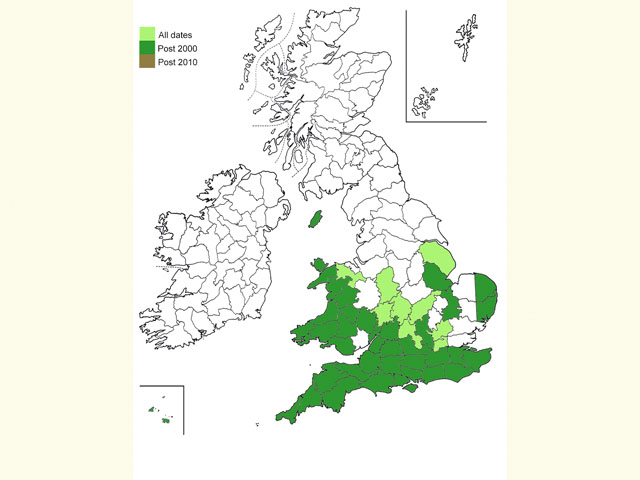Zygaenidae
54.010 Five-spot Burnet Zygaena trifolii decreta Verity, 1925
Local S. and SW. England, Berks. and Bucks. and parts of Wales
Zygaena trifolii palustrella Verity, 1925
Local S. England from Gloucs. to Kent, Berks. and Bucks.
Zygaena trifolii subcyracusia Verity, 1925
Channel Islands
Similar species: There is a rare form with yellow spots. Narrow-bordered 5-spot Burnet Zygaena lonicerae is very difficult to separate from this species even by genitalia, although the red spots are rarely touching or merged in the commoner ssp.latomarginata. Touching spots are common with 5-spot Burnet.
Forewing: 14 to 19mm
Habitats: Ssp.palustrella is usually found on dry calcareous grassland from late May through June.
Ssp.decreta was thought to be only on damp grassland, wetlands and heathland from July until early August, but since 2003 many colonies have been found in Cornwall on dry grassland, dry dune slacks and sand-dunes feeding on Common Bird's-foot Trefoil.
Habits: All three subspecies fly in sunny weather and nectar at flowers in their particular habitat.
Foodplant: The larva of the ssp.palustrella feeds on Common Bird's-foot Trefoil. It may overwinter twice and pupates in a cocoon hidden low in the vegetation.
The ssp.decreta is more often found on Greater Bird's-foot Trefoil and only occasionally on Common Bird's-foot Trefoil. It may overwinter twice and pupates in a cocoon exposed on the stem of a tall plant.
The larva of the ssp.subcyracusia has similar habits to ssp.palustrella.





